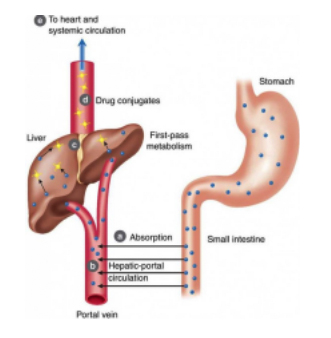Metabolism of CBD
Canabidiol (can·na·bi·di·ol), or CBD is one of over 100 cannabinoids present in Marijuana and Hemp, and is typically the second most abundant. Discovered in 1940, CBD is historically best known for its ability to mitigate the more extreme psychoactive effects of THC (e.g., anxiety and paranoia). In the last decade, CBD has become widely known for its ability to manage some seizure disorders. Its recent widespread popularity stems from the same benefits found in THC, including treating pain (analgesic), nausea (antiemetic), and inflammation, but without the psychoactive effects that accompany THC.
While the science community has been studying THC since the 1960s, there is still comparatively little known about CBD and its mechanisms of action. Nonetheless, there is general consensus exists about the CBD’s multiple molecular pathways, namely its binding affinity with non-endocannabinoid receptors such as 5-HT1A Serotonin and TRPV-1. These receptors are present throughout the brain and central nervous system and affect a variety of biological functions, ranging from blood pressure and heart rate, to body temperature and metabolism.
Key to the benefits of CBD is how the molecule is metabolized and processed in the human body. And how metabolization contributes to the CBD’s effects.
Understanding CBD Metabolism
 In considering the effectiveness of a drug, how the drug is metabolized, or broken down in the liver, can be as important as the drug itself. Researchers examine not only how a drug is metabolized, but also how other drugs influence its metabolism, and how the drug influences the metabolism of other drugs.
In considering the effectiveness of a drug, how the drug is metabolized, or broken down in the liver, can be as important as the drug itself. Researchers examine not only how a drug is metabolized, but also how other drugs influence its metabolism, and how the drug influences the metabolism of other drugs.
Metabolism
Metabolism relates to how drugs are broken down in the liver to aid in elimination of waste and undesirable compounds. Taken orally, a drug goes through a ‘first-pass effect’, in which it is absorbed by the digestive system via hepatic portal circulation, and then into the bloodstream to the liver, before it reaches the rest of the body.
The majority of the metabolic processes occur in the liver, and while this greatly reduces the bioavailability1 of the drug, in some cases the resulting metabolites (products of metabolism) may also have a pharmacological effect. For example, certain drugs such as codeine and tramadol have metabolites (morphine and O desmethyltramadol respectively) that are stronger than the original
drug itself.
CBD Metabolites and Their Therapeutic Potential
In the case of CBD, the most abundantly found metabolites are hydroxylated 7-COOH derivatives. While comparatively little is known about CBD’s metabolites compared to THC, one British biopharmaceutical company specializing in cannabis plant derivatives, holds a patent on the CBD metabolite 7-hydroxy cannabidiol (7-OH-CBD) for use in the treatment of non-alcoholic fatty liver disease. More than a few companies are now researching the therapeutic effects of not only the cannabinoid itself, but also its metabolites.
CBD Bioavailability
Bioavailability is the proportion of a drug that enters (blood) circulation when introduced into the body and so is able to have an active effect. The oral bioavailability of CBD is typically between 13 and 19%, while its bioavailability via inhalation is 11 to 45% (with a mean of 31%).2, 3 The elimination half-life of CBD is typically between 18 and 32 hours.4 These numbers are relevant in that they largely parallel the bioavailability of THC and other cannabinoids.
Effects of CBD On Other Medications
CBD, while not shown to specifically interact with other drugs, can have an impact on how the body processes them. An article published on Project CBD by Adrian Devitt-Lee describes how “CBD and other plant cannabinoids can potentially interact with many pharmaceuticals by inhibiting the activity of Cytochrome P450, a family of liver enzymes. This key enzyme group metabolizes most of the drugs we consume, including more than 60 percent of marketed meds.”
The author continues, “By occupying the site of enzymatic activity, CBD displaces its chemical competitors and prevents Cytochrome P450 from metabolizing other compounds.” In effect, if someone is taking other pharmaceutical medication alongside CBD, the potential receptor blocking action of CBD may impede the prescription drug’s metabolism, resulting in higher levels (of that drug) in the bloodstream and potential toxicity from it.
Another example is a clinical study at Massachusetts General Hospital involving children with refractory epilepsy, who took CBD alongside the anticonvulsant medication, Clobazam. Researchers determined that CBD increased the concentration of Clobazam in the blood, which required a reduction in dose as a result. Despite the common view that CBD has few or no side effects, patients on prescription medications should inform their health care professional if taking CBD. Periodic tests for levels of medication in the blood would enable adjustment in dosing if needed.
_____________________________________________________________________________________________
2. ElSohly M, Gul W. Constituents of Cannabis sativa. In: Handbook of Cannabis (Pertwee RG, ed.). Oxford University Press: Oxford, 2014, pp. 3–22.
3. Volkow ND. The biology and potential therapeutic effects of cannabidiol. Testimony before the US Senate Caucus on International Narcotics Control ‘‘Cannabidiol: barriers to research and potential medical benefits’’, June 24 2015, DHHS, NIH-NIDA, Washington, D.C. Available at: www.drugcaucus.senate.gov/sites/default/files/Volkow.pdf (accessed January 31, 2016).
4. Gaoni Y, Mechoulam R. Isolation, structure, and partial synthesis of an active constituent of hashish. J Am Chem Soc. 1964; 86:1646–1647
Metabolism of CBD 2